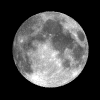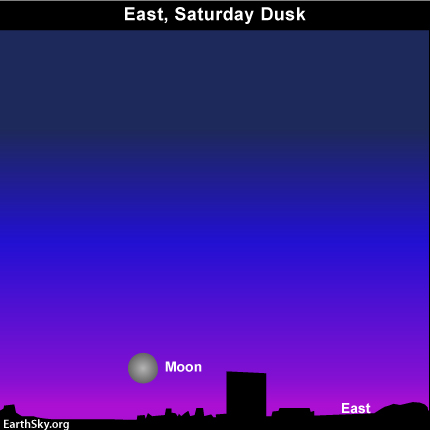Courtesy of EarthSky
A Clear Voice for Science
www.EarthSky.org

 For the northern hemisphere, last night’s moon was the full Hunter’s Moon. In the southern hemisphere, it was the second full moon of spring.
For the northern hemisphere, last night’s moon was the full Hunter’s Moon. In the southern hemisphere, it was the second full moon of spring.
The full moon reached the crest of its full phase today (Saturday, October 23) at 1:36 Universal Time. For the Central Time zone in the U.S., that was 8:36 p.m. yesterday, on Friday, October 22.
Tonight’s moon is past full. It is actually a waning moon. However, no matter where you live worldwide, it will be a full-looking waning gibbous moon – not a full moon – that will be rising over your east-northeast horizon this Saturday evening. As a rule of thumb, the moon rises approximately 50 minutes later daily.
However, it is early autumn in the northern hemisphere now, and at this time of year, that rule is broken for the several nights following the full moon. If you reside far enough north of the equator, in fact, you may even see tonight’s waning moon rising before sunset. At Fairbanks, Alaska, for instance, the waning moon will rise before sunset for the next several days.
Our charts are designed for temperate latitudes in North America. Look at the position of yesterday’s full Hunter’s Moon 24 hours ago. (Look at East on the sky chart.) Now note the waning gibbous moon on today’s chart. After 24 hours, the moon has swung almost sideways (instead of downward), so that is why the waning moon rises sooner after sunset in autumn than at other seasons.
Last night, the full Hunter’s Moon shone all night long last night. However, watch again tonight, as the waning gibbous moon repeats the performance, lighting up the nighttime from dusk until dawn!
Hunter’s Moon to rise as the sun sets on October 22
Looking for a sky almanac? Earthsky recommends
Tonight for the telescope:
Two of Jupiter’s moons, Europa and Ganymede, simultaneously cast their shadows on Jupiter this Saturday evening, from 9:40 to 11:04 p.m. Eastern Time (8:40 to 10:04 p.m. Central Time, 7:40 to 9:40 p.m. Mountain Time and 6:40 to 8:04 p.m. Pacific Time). Individually, Ganymede’s shadow crosses Jupiter’s disk from 8:06 to 11:04 p.m. Eastern Time, and Europa’s shadow crosses it from 9:40 p.m. to 12:23 a.m. (on Sunday, September 24) Eastern Time.
Written by Bruce McClure
Astronomy Picture of the Day from NASA/JPL
U.S. Naval Observator Astronomical Information center